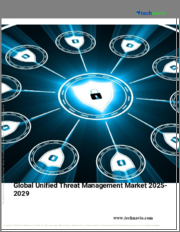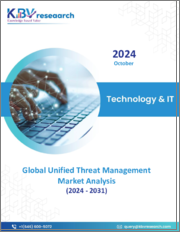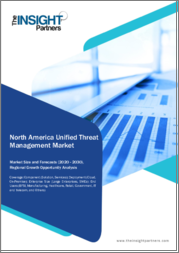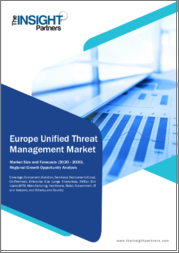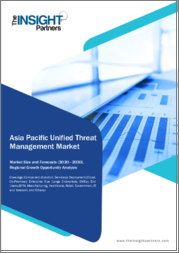
|
시장보고서
상품코드
1533123
아시아태평양의 통합 위협 관리 시장 예측(-2030년) : 지역별 분석 - 구성요소별, 전개별, 기업 규모별, 최종사용자별Asia Pacific Unified Threat Management Market Forecast to 2030 - Regional Analysis - by Component, Deployment, Enterprise Size, and End Users |
||||||
아시아태평양의 통합 위협 관리 시장은 2022년에 13억 473만 달러로 평가되며, 2030년에는 32억 9,379만 달러에 달할 것으로 예상되며, 2022년부터 2030년까지 연평균 12.3%의 성장률을 기록할 것으로 예상됩니다.
헬스케어의 디지털화, 아시아태평양의 통합 위협 관리 시장을 견인
헬스케어 기관은 환자 치료와 중요한 서비스를 제공하기 위해 기술에 대한 의존도가 높아지는 등 디지털 혁신이 크게 진행되고 있습니다. 헬스케어 산업의 디지털화는 언제 어디서나 의료 정보 및 서비스에 접근할 수 있게함으로써 적시에 효율적인 환자 치료를 가능하게 합니다. 디지털화는 의료 서비스를 강화하기 위한 여러 가지 도구와 방법을 도입하고 있습니다. 이러한 도구들은 환자뿐만 아니라 의사도 접근할 수 있는 환자 정보 및 건강 관련 데이터를 기록하는 데 도움이 되고 있습니다. 그러나 헬스케어 시스템의 디지털화가 진행되면서 이 산업은 다양한 종류의 사이버 공격과 위협에 노출되기 쉬워지고 있습니다. 예를 들어, 체크포인트 소프트웨어 테크놀러지스 리미티드(Check Point Software Technologies Limited)의 체크포인트 조사(CPR)에 따르면, 2022년 의료 기관이 경험한 공격은 매주 1,426건으로 2021년에 비해 60% 이상 증가한 것으로 나타났습니다. 이처럼 헬스케어 산업에서 사이버 공격 위협의 증가와 디지털화는 보안 솔루션 강화에 대한 수요를 창출할 수 있습니다. 통합 위협 관리 솔루션은 분산서비스거부(DDoS), 랜섬웨어, 피싱, 멀웨어 등의 공격으로부터 의료 기관을 보호할 수 있습니다. 이처럼 헬스케어 시스템의 디지털화는 아시아태평양의 통합 위협 관리 시장 성장에 유리한 기회를 창출할 것입니다.
아시아태평양 통합 위협 관리 시장 개요
아시아태평양의 통합 위협 관리 시장은 호주, 중국, 인도, 일본, 한국 및 기타 아시아태평양으로 구분되며, 2022년 IBM의 보고서에 따르면 사이버 공격의 영향은 세계 경제의 거의 모든 산업에 영향을 미쳤다고 합니다. 주요 공격 대상 산업은 제조업(25%), 금융 및 보험(19%), 전문-비즈니스-소비자(PBC) 서비스(15%) 등입니다. 아시아태평양은 가장 많은 공격을 받은 지역으로 31%의 공격을 받았습니다. 아시아태평양의 사이버 공격 증가는 통합 위협 관리 솔루션에 대한 수요를 촉진하고 있습니다. 또한, Positive Technologies의 보고서에 따르면, 사이버 스파이 활동은 아시아 지역 조직과 국가에 큰 위협이 되고 있습니다. 조직에 대한 공격의 49%는 기밀 정보 유출에 성공했습니다. 정부와 조직은 연구와 기술에 많은 투자를 하고 있으며, 이러한 정보를 훔치면 경쟁사에게 기술적 우위를 점할 수 있습니다. 이는 사이버 스파이 조직의 활동이 활발해지고 있다는 것을 말해주고 있습니다. 또한 넷스카우트시스템즈의 DDoS 위협 인텔리전스 보고서에 따르면, 2023년 아시아태평양의 DDoS 공격은 총 150만 건으로 2022년에 비해 16% 증가할 것으로 예상했습니다. 공격의 최대 대역폭은 632Gbps, 최대 처리량은 316Mpps에 달합니다. 사이버 공격의 증가는 아시아태평양에서 통합 위협 관리 기술의 채택을 촉진하고 있습니다.
아시아태평양 통합 위협 관리 시장 세분화
아시아태평양의 통합 위협 관리 시장은 구성요소, 배포, 기업 규모, 최종사용자 및 국가에 따라 세분화됩니다.
컴포넌트를 기준으로 아시아태평양의 통합 위협 관리 시장은 솔루션과 서비스로 양분되며, 2022년에는 솔루션 부문이 큰 비중을 차지했습니다.
전개 측면에서 아시아태평양의 통합 위협 관리 시장은 클라우드와 온프레미스로 양분되며, 2022년에는 클라우드 부문이 더 큰 점유율을 차지했습니다.
기업 규모에 따라 아시아태평양의 통합 위협 관리 시장은 대기업과 중소기업으로 양분되며, 2022년에는 대기업 부문이 더 큰 비중을 차지했습니다.
최종사용자별로 아시아태평양의 통합 위협 관리 시장은 BFSI, 제조, 헬스케어, 소매, 정부, IT 및 통신, 기타로 분류되며, 2022년에는 IT 및 통신 부문이 가장 큰 점유율을 차지했습니다.
국가별로는 아시아태평양의 통합 위협 관리 시장은 호주, 중국, 인도, 일본, 한국, 기타 아시아태평양으로 분류됩니다. 중국은 2022년 아시아태평양의 통합 위협 관리 시장을 장악했습니다.
Fortinet Inc., Sophos Ltd., Juniper Networks Inc, Cisco Systems Inc, Huawei Technologies Co Ltd, Barracuda Networks, Inc. Technologies Inc., Check Point Software Technologies Ltd. 등이 아시아태평양의 통합 위협 관리 시장에서 사업을 전개하고 있는 주요 기업들입니다.
목차
제1장 소개
제2장 주요 요약
- 주요 인사이트
- 시장 매력
제3장 조사 방법
- 조사 범위
- 2차 조사
- 1차 조사
제4장 아시아태평양의 통합 위협 관리 시장 상황
- 생태계 분석
- 밸류체인 벤더 리스트
제5장 아시아태평양의 통합 위협 관리 시장 : 주요 산업 역학
- 성장 촉진요인
- 데이터 침해 사례 증가
- 중소기업에 대한 정부 투자와 이니셔티브 확대
- 통신 산업 확대
- 시장 성장 억제요인
- 통합 솔루션 증가
- 시장 기회
- 헬스케어 디지털화
- 클라우드 기술의 도입 확대
- 향후 동향
- 인공지능과 머신러닝의 통합
- 성장 촉진요인과 억제요인의 영향
제6장 통합 위협 관리 시장 : 아시아태평양 시장 분석
- 아시아태평양의 통합 위협 관리 시장 판매량, 2022-2030년
- 아시아태평양의 통합 위협 관리 시장 예측과 분석
제7장 아시아태평양의 통합 위협 관리 시장 분석 : 구성요소
- 솔루션
- 솔루션 시장 매출과 2030년까지 예측
- 서비스
- 서비스 개요
- 서비스 시장 매출과 2030년까지 예측
- 컨설팅
- 서비스 개요
- 컨설팅 시장 매출과 2030년까지 예측
- 지원·보수·기타
- 서포트, 보수, 기타 시장 매출과 2030년까지 예측
제8장 아시아태평양의 통합 위협 관리 시장 분석 : 전개
- 클라우드
- 클라우드 시장 매출과 2030년까지 예측
- 온프레미스
- 온프레미스 개요
- 온프레미스 시장 매출과 2030년까지 예측
제9장 아시아태평양의 통합 위협 관리 시장 분석 : 기업 규모
- 대기업
- 대기업 시장 매출과 2030년까지 예측
- 중소기업
- 중소기업 시장 매출과 2030년까지 예측
제10장 아시아태평양의 통합 위협 관리 시장 분석 : 최종사용자
- BFSI
- BFSI 시장 매출과 2030년까지 예측
- 제조업
- 제조업 개요
- 제조업 시장 매출과 2030년까지 예측
- 헬스케어
- 헬스케어 시장 매출과 2030년까지 예측
- 소매
- 소매 시장 매출과 2030년까지 예측
- 정부기관
- 관공청 시장 매출과 2030년까지 예측
- IT 및 통신
- IT 및 통신 시장 매출과 2030년까지 예측
- 기타
- 기타 개요
- 기타 시장 매출과 2030년까지 예측
제11장 아시아태평양의 통합 위협 관리 시장 : 국가별 분석
- 호주
- 중국
- 인도
- 일본
- 한국
- 기타 아시아태평양
제12장 업계 상황
- 시장 이니셔티브
- 제품 개발
제13장 기업 개요
- Fortinet Inc
- Sophos Ltd.
- Cisco Systems Inc
- Juniper Networks Inc
- Huawei Technologies Co Ltd
- Barracuda Networks, Inc.
- WatchGuard Technologies Inc
- Check Point Software Technologies Ltd
제14장 부록
ksm 24.08.22The Asia Pacific unified threat management market was valued at US$ 1,304.73 million in 2022 and is expected to reach US$ 3,293.79 million by 2030; it is estimated to register at a CAGR of 12.3% from 2022 to 2030.
Digitalization in Healthcare Fuels Asia Pacific Unified Threat Management Market
Healthcare institutions are undergoing a significant digital transformation involving a mounting reliance on technology to deliver patient care and critical services. The rising digitalization in the healthcare industry offers access to medical information and services from anytime, anywhere, and ensures timely and efficient patient care. Digitalization has resulted in the introduction of several tools and methods for enhancing healthcare services. These tools help to keeps the record of patients' information and health-related data accessible to doctors as well as patients. However, due to growing digitalization in healthcare systems, the industry has become prone to various kinds of cyberattacks and threats. For instance, according to Check Point Software Technologies Ltd's Check Point Research (CPR), healthcare institutions experienced 1,426 weekly attacks in 2022, an increase of over 60% compared to 2021. Thus, the rising threats of cyberattacks and digitalization in the healthcare industry can generate the demand for enhanced security solutions. A unified threat management solution can protect healthcare institutions from attacks such as distributed denial of service (DDoS), ransomware, phishing, and malware. Thus, digitalization in the healthcare system creates lucrative opportunities for the Asia Pacific unified threat management market growth.
Asia Pacific Unified Threat Management Market Overview
The Asia Pacific unified threat management market is segmented into Australia, China, India, Japan, South Korea, and the Rest of Asia Pacific. According to the report of IBM in 2022, the impacts of cyberattacks were felt throughout nearly all industries of the global economy. The leading industries that were attacked include manufacturing (25%), finance & insurance (19%), and professional, business, and consumer (PBC) services (15%). APAC was the most targeted region, finding itself subject to 31% of attacks. The increasing number of cyberattacks in APAC is fueling the demand for unified threat management solutions. Also, according to the report of Positive Technologies, cyber espionage is a major threat to organizations and states in Asia. As many as 49% of successful attacks on organizations resulted in compromise of sensitive information. Governments and organizations invest heavily in research and technology, and stealing this kind of information can give competitors a technological advantage. This explains the increased activity by cyberespionage gangs. Additionally, according to NetScout Systems, Inc.'s DDoS threat intelligence report, the total number of DDoS attacks in Asia Pacific was 1.5 million, in 2023, which is 16% higher as compared to 2022. The maximum bandwidth of the attacks is 632 Gbps, and the maximum throughput is 316 Mpps. The increase in cyberattacks is propelling the adoption of unified threat management technologies in Asia Pacific.
Asia Pacific Unified Threat Management Market Segmentation
The Asia Pacific unified threat management market is segmented based on component, deployment, enterprise size, end users, and country.
Based on component, the Asia Pacific unified threat management market is bifurcated into solution and services. The solution segment held a larger share in 2022.
In terms of deployment, the Asia Pacific unified threat management market is bifurcated into cloud and on-premise. The cloud segment held a larger share in 2022.
By enterprise size, the Asia Pacific unified threat management market is bifurcated into large enterprises and SMEs. The large enterprises segment held a larger share in 2022.
In terms of end users, the Asia Pacific unified threat management market is segmented into BFSI, manufacturing, healthcare, retail, government, IT & Telecom, and others. The IT & Telecom segment held the largest share in 2022.
Based on country, the Asia Pacific unified threat management market is categorized into Australia, China, India, Japan, South Korea, and the Rest of Asia Pacific. China dominated the Asia Pacific unified threat management market in 2022.
Fortinet Inc, Sophos Ltd., Juniper Networks Inc, Cisco Systems Inc, Huawei Technologies Co Ltd, Barracuda Networks, Inc., WatchGuard Technologies Inc, and Check Point Software Technologies Ltd are some of the leading companies operating in the Asia Pacific unified threat management market.
Table Of Contents
1. Introduction
- 1.1 The Insight Partners Research Report Guidance
- 1.2 Market Segmentation
2. Executive Summary
- 2.1 Key Insights
- 2.2 Market Attractiveness
3. Research Methodology
- 3.1 Coverage
- 3.2 Secondary Research
- 3.3 Primary Research
4. Asia Pacific Unified Threat Management Market Landscape
- 4.1 Overview
- 4.2 Ecosystem Analysis
- 4.2.1 List of Vendors in the Value Chain:
5. Asia Pacific Unified Threat Management Market - Key Industry Dynamics
- 5.1 Drivers
- 5.1.1 Rising Cases of Data Breach
- 5.1.2 Growing Government Investments and Initiatives for SMEs
- 5.1.3 Expansion of Telecom Industry
- 5.2 Market Restraints
- 5.2.1 Growing Number of Integrated Solution
- 5.3 Market Opportunities
- 5.3.1 Digitalization in Healthcare
- 5.3.2 Increasing Deployment of Cloud Technology
- 5.4 Future Trend
- 5.4.1 Integration of Artificial Intelligence and Machine Learning
- 5.5 Impact of Drivers and Restraints:
6. Unified Threat Management Market - Asia Pacific Market Analysis
- 6.1 Asia Pacific Unified Threat Management Market Revenue (US$ Million), 2022 - 2030
- 6.2 Asia Pacific Unified Threat Management Market Forecast and Analysis
7. Asia Pacific Unified Threat Management Market Analysis - Component
- 7.1 Solution
- 7.1.1 Overview
- 7.1.2 Solution Market Revenue and Forecasts to 2030 (US$ Million)
- 7.2 Services
- 7.2.1 Overview
- 7.2.2 Services Market Revenue and Forecasts to 2030 (US$ Million)
- 7.2.3 Consulting
- 7.2.3.1 Overview
- 7.2.4 Consulting Market Revenue and Forecasts to 2030 (US$ Million)
- 7.2.5 Support, Maintenance & Others
- 7.2.5.1 Overview
- 7.2.6 Support, Maintenance & Others Market Revenue and Forecasts to 2030 (US$ Million)
8. Asia Pacific Unified Threat Management Market Analysis - Deployment
- 8.1 Cloud
- 8.1.1 Overview
- 8.1.2 Cloud Market Revenue and Forecasts to 2030 (US$ Million)
- 8.2 On-premises
- 8.2.1 Overview
- 8.2.2 On-premises Market Revenue and Forecasts to 2030 (US$ Million)
9. Asia Pacific Unified Threat Management Market Analysis - Enterprise Size
- 9.1 Large Enterprises
- 9.1.1 Overview
- 9.1.2 Large Enterprises Market Revenue and Forecasts to 2030 (US$ Million)
- 9.2 SMEs
- 9.2.1 Overview
- 9.2.2 SMEs Market Revenue and Forecasts to 2030 (US$ Million)
10. Asia Pacific Unified Threat Management Market Analysis - End Users
- 10.1 BFSI
- 10.1.1 Overview
- 10.1.2 BFSI Market Revenue and Forecasts to 2030 (US$ Million)
- 10.2 Manufacturing
- 10.2.1 Overview
- 10.2.2 Manufacturing Market Revenue and Forecasts to 2030 (US$ Million)
- 10.3 Healthcare
- 10.3.1 Overview
- 10.3.2 Healthcare Market Revenue and Forecasts to 2030 (US$ Million)
- 10.4 Retail
- 10.4.1 Overview
- 10.4.2 Retail Market Revenue and Forecasts to 2030 (US$ Million)
- 10.5 Government
- 10.5.1 Overview
- 10.5.2 Government Market Revenue and Forecasts to 2030 (US$ Million)
- 10.6 IT and Telecom
- 10.6.1 Overview
- 10.6.2 IT and Telecom Market Revenue and Forecasts to 2030 (US$ Million)
- 10.7 Others
- 10.7.1 Overview
- 10.7.2 Others Market Revenue and Forecasts to 2030 (US$ Million)
11. Asia Pacific Unified Threat Management Market -Country Analysis
- 11.1 Asia Pacific Unified Threat Management Market
- 11.1.1 Asia Pacific Unified threat management market Breakdown by Countries
- 11.1.1.1 Australia Unified Threat Management Market Revenue and Forecasts to 2030 (US$ Mn)
- 11.1.1.1.1 Australia Unified Threat Management Market Breakdown by Component
- 11.1.1.1.2 Australia Unified Threat Management Market Breakdown by Deployment
- 11.1.1.1.3 Australia Unified Threat Management Market Breakdown by Enterprise Size
- 11.1.1.1.4 Australia Unified Threat Management Market Breakdown by End Users
- 11.1.1.2 China Unified Threat Management Market Revenue and Forecasts to 2030 (US$ Mn)
- 11.1.1.2.1 China Unified Threat Management Market Breakdown by Component
- 11.1.1.2.2 China Unified Threat Management Market Breakdown by Deployment
- 11.1.1.2.3 China Unified Threat Management Market Breakdown by Enterprise Size
- 11.1.1.2.4 China Unified Threat Management Market Breakdown by End Users
- 11.1.1.3 India Unified Threat Management Market Revenue and Forecasts to 2030 (US$ Mn)
- 11.1.1.3.1 India Unified Threat Management Market Breakdown by Component
- 11.1.1.3.2 India Unified Threat Management Market Breakdown by Deployment
- 11.1.1.3.3 India Unified Threat Management Market Breakdown by Enterprise Size
- 11.1.1.3.4 India Unified Threat Management Market Breakdown by End Users
- 11.1.1.4 Japan Unified Threat Management Market Revenue and Forecasts to 2030 (US$ Mn)
- 11.1.1.4.1 Japan Unified Threat Management Market Breakdown by Component
- 11.1.1.4.2 Japan Unified Threat Management Market Breakdown by Deployment
- 11.1.1.4.3 Japan Unified Threat Management Market Breakdown by Enterprise Size
- 11.1.1.4.4 Japan Unified Threat Management Market Breakdown by End Users
- 11.1.1.5 South Korea Unified Threat Management Market Revenue and Forecasts to 2030 (US$ Mn)
- 11.1.1.5.1 South Korea Unified Threat Management Market Breakdown by Component
- 11.1.1.5.2 South Korea Unified Threat Management Market Breakdown by Deployment
- 11.1.1.5.3 South Korea Unified Threat Management Market Breakdown by Enterprise Size
- 11.1.1.5.4 South Korea Unified Threat Management Market Breakdown by End Users
- 11.1.1.6 Rest of Asia Pacific Unified Threat Management Market Revenue and Forecasts to 2030 (US$ Mn)
- 11.1.1.6.1 Rest of Asia Pacific Unified Threat Management Market Breakdown by Component
- 11.1.1.6.2 Rest of Asia Pacific Unified Threat Management Market Breakdown by Deployment
- 11.1.1.6.3 Rest of Asia Pacific Unified Threat Management Market Breakdown by Enterprise Size
- 11.1.1.6.4 Rest of Asia Pacific Unified Threat Management Market Breakdown by End Users
- 11.1.1.1 Australia Unified Threat Management Market Revenue and Forecasts to 2030 (US$ Mn)
- 11.1.1 Asia Pacific Unified threat management market Breakdown by Countries
12. Industry Landscape
- 12.1 Overview
- 12.2 Market Initiative
- 12.3 Product Development
13. Company Profiles
- 13.1 Fortinet Inc
- 13.1.1 Key Facts
- 13.1.2 Business Description
- 13.1.3 Products and Services
- 13.1.4 Financial Overview
- 13.1.5 SWOT Analysis
- 13.1.6 Key Developments
- 13.2 Sophos Ltd.
- 13.2.1 Key Facts
- 13.2.2 Business Description
- 13.2.3 Products and Services
- 13.2.4 Financial Overview
- 13.2.5 SWOT Analysis
- 13.2.6 Key Developments
- 13.3 Cisco Systems Inc
- 13.3.1 Key Facts
- 13.3.2 Business Description
- 13.3.3 Products and Services
- 13.3.4 Financial Overview
- 13.3.5 SWOT Analysis
- 13.3.6 Key Developments
- 13.4 Juniper Networks Inc
- 13.4.1 Key Facts
- 13.4.2 Business Description
- 13.4.3 Products and Services
- 13.4.4 Financial Overview
- 13.4.5 SWOT Analysis
- 13.4.6 Key Developments
- 13.5 Huawei Technologies Co Ltd
- 13.5.1 Key Facts
- 13.5.2 Business Description
- 13.5.3 Products and Services
- 13.5.4 Financial Overview
- 13.5.5 SWOT Analysis
- 13.5.6 Key Developments
- 13.6 Barracuda Networks, Inc.
- 13.6.1 Key Facts
- 13.6.2 Business Description
- 13.6.3 Products and Services
- 13.6.4 Financial Overview
- 13.6.5 SWOT Analysis
- 13.6.6 Key Developments
- 13.7 WatchGuard Technologies Inc
- 13.7.1 Key Facts
- 13.7.2 Business Description
- 13.7.3 Products and Services
- 13.7.4 Financial Overview
- 13.7.5 SWOT Analysis
- 13.7.6 Key Developments
- 13.8 Check Point Software Technologies Ltd
- 13.8.1 Key Facts
- 13.8.2 Business Description
- 13.8.3 Financial Overview
- 13.8.4 SWOT Analysis
- 13.8.5 Key Developments
14. Appendix
- 14.1 Word Index






